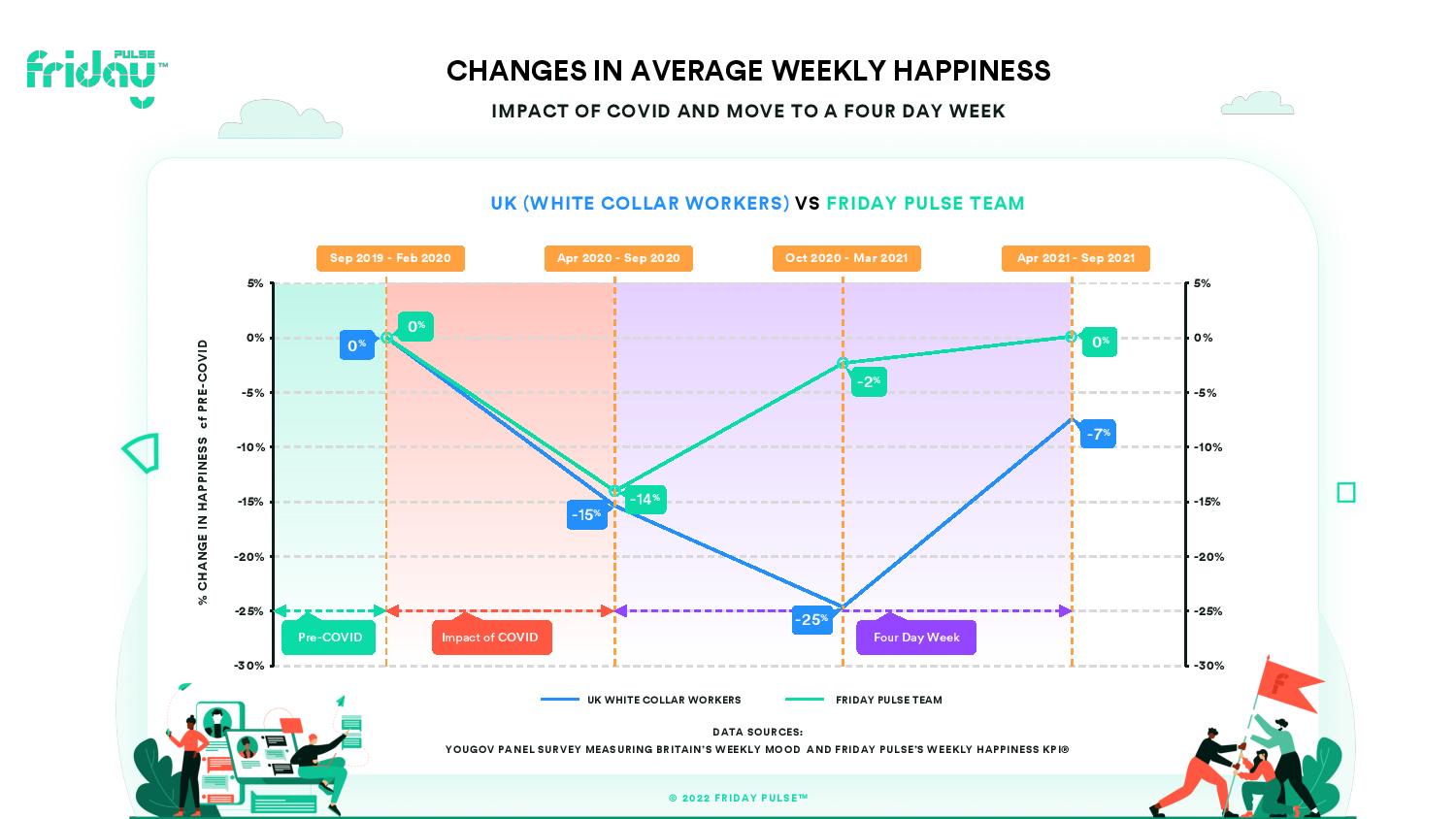With less time to work, our people are both happier and more productive. It’s an adaptation that not just suited the needs of our people, but also our organization.
At Friday Pulse we don’t just help clients with employee wellbeing, we also strive to make our own workplace better. Like so many of our clients that use our platform, we’ve improved our own employee experience and unlocked greater productivity through tracking our happiness scores.
Our 4-day work week statistics
The 4-day work week has been in the news a lot lately because it’s becoming an
increasingly attractive option to combat low morale. And, with a pilot scheme currently being trailed by 30 UK companies to measure the impact on productivity and wellbeing, we can now report on what we’ve experienced:
- 80% of our people said that they were now more efficient in managing their time
- 100% reported better work-life balance
- 80% were more productive
- 75% said the new work week reduced unnecessary meetings
- 100% were in favour of continuing with a 4-day work week
With more free time for hobbies, volunteering and family, and unlike other wellbeing initiatives, our staff continue to describe it as a “privilege” and the
“gift that keeps on giving.”
Why we switched to a 4-day work week
We realized in 2020 that the pandemic wasn’t going to end any time soon.
Even in our own company, work-life balance had eroded and people were feeling overworked. To combat this, we opted to transition the company to a 4-day work week.
Of course, we had concerns. We were aiming for 32 hours instead of the normal 40 – while still going providing a 5-day service to our clients.
There was a lot we learned on the fly, adjusting as we went. To allow for this, we made sure to check in with our people every week to see how the transition was going.
It was difficult at first — we’ve been programmed for 40-hour work weeks since we were in primary school.
After a tough six months, we managed to restore our team happiness scores to pre-pandemic levels while simultaneously growing the business by 11% a month.
Benefits of a 4-day work week
1. Unexpected collaboration
Because we were still servicing our clients 5 days a week, we held honest conversations with our people around working time – arriving at a new way of working. In hindsight, it shouldn’t be surprising that our collaboration and communication improved dramatically, and we were able to feel more cohesive as a work unit despite working fewer hours.
2. Improved health and stamina
Every year burnout costs the US economy almost $190 billion and the UK economy £45 billion. We switched to a 4-day workweek to help counter burnout and improve stamina during the peak of COVID, making sure that we could ride out the pandemic and have our people come out on top.
3. No dip in performance, responsiveness, or client satisfaction
We were able to grow the company by 11% (month on month) and reduce
the number of hours we worked while still providing the same level of
service to our clients – highlighting you can improve team happiness
while increasing your organization’s productivity and performance.
The impact of a 4-day week on happiness levels
The pandemic disrupted everyone’s experience of both life and work. In
the first six months, our team reported a 14% drop in weekly happiness
scores. At the time we implemented the 4-day week, we didn’t know that
our results were universal. We only knew that our people’s happiness
scores were falling fast, and we needed to do something quickly.
Later, we learned from the 2021 World Happiness Report how the
dramatic drop in happiness scores was for white collar workers across
the UK — 15% over the first six months of the pandemic.

By September 2020, scores were on an upward trajectory, but people were
still feeling burned out. Against this backdrop we introduced the 4-day
work week. Almost immediately, our happiness scores climbed back to 98%
of pre-pandemic levels. Meanwhile, the rest of the UK fell to 75%.

Fig. 1: We grouped our data into 6-month periods with over 250
measures of weekly happiness within Friday Pulse (10 people x 26 weeks),
ensuring the difference between FP and the UK are statistically
significant (at 99% confidence levels).
During 2021 restrictions began to ease, and while the UK started to
recover, Friday Pulse recovered to pre-pandemic levels and maintained a
high average happiness score into 2022.
There’s no doubt that while the switch to the four-day work week
improved the happiness of our team, it also acted as an extra layer of
protection against the ongoing challenges of COVID.
And, as a result, with high happiness scores, we were able to triple
our clients and revenue between September 2020 and 2021.
How to switch to 4-day work week
Not every company is ready for a transition into a four-day workweek. However, here are some of the considerations we went through in deciding if we were ready. We hope these policies help you as you think about the transition.
1. Keeping track of time
The question we had to answer was, “how do we spend our workday?” Time is the most precious commodity in a four-day week.
When we were trying to make this decision, we kept time diaries to track how we were spending our time. We looked at what was essential, what added the most value, and what kind of downtime we had.
2. Trim the fat
What could we cut? Concerned with efficiency and productivity, we looked at the length of meetings, how we could give people uninterrupted time to work, and the activities that added the most value.
As a result, we’ve reduced the number of meetings we’re having. We’re also capping the number of people in a meeting to make sure that it’s more focused and we’re getting the most interaction out of people.
3. Rotating schedule and communication
One thing we wanted to make sure we continued was our quality of service to customers, every day of the working week. It’s clear that not everyone can have a Friday off — some would have to have Mondays or other days off, instead.
To make things easier on ourselves, we settled on what channels we were going to use to communicate with each other and who would be “on-call” if anything happened.
To ensure that people had time to focus on their work instead of fielding questions all day, we determined an ‘office hours’ set up for everyone that they were available and online to answer questions and interruptions.
Track your employee happiness levels with Friday Pulse
We had another recent review of the 4-day day workweek and universally decided to keep it. We’ve had a lot to celebrate, and we’ve taken the time to reflect and congratulate our people for adapting well to it. There’s still lots of room for improvement for us, but we’re keeping a close ear to what our people are saying and making continual adjustments.
If switching over is something you’ve considered but need help, please contact our Relationships Manager, Megan, on megan@fridaypulse.com.
We’d be happy to help you with your transition and in measuring the positive impact a move to a condensed working week
will have on your employee happiness levels.







